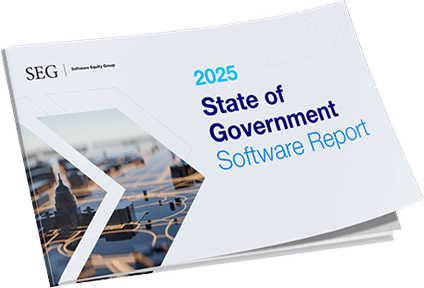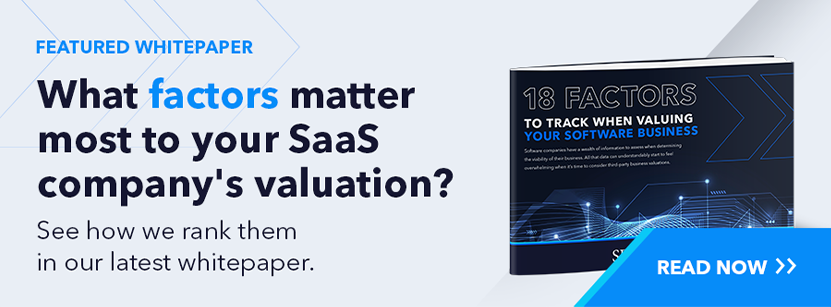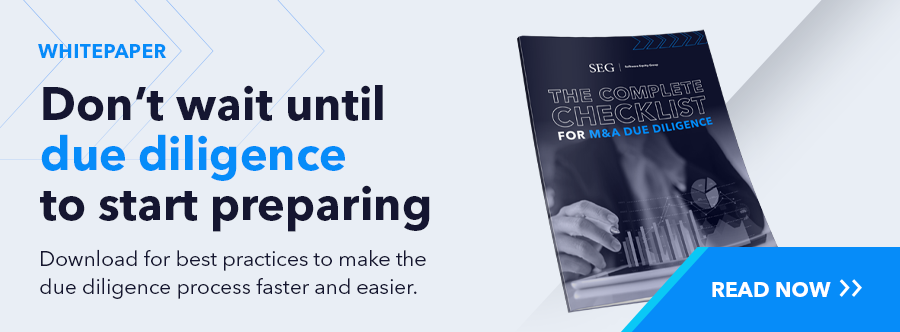
M&A Glossary
Terms You Need to Know
Even for experts, going through an M&A process can introduce various new terms that seem unfamiliar, or take on new definitions in the new setting.
In order to help SaaS executives stay on the same page as buyers, we’ve compiled a holistic M&A glossary that includes:
- A comprehensive list of common M&A terms
- Definitions of key industry terms
- Additional resources to help you learn more about each term in depth
If you have any questions about these terms or definitions, feel free to reach out to SEG’s experts.

The firm or company that is purchasing the company during an acquisition. Strategic buyers buy other companies for synergies and differentiation, or to fill a hole in their product offering. Financial buyers (private equity firms) buy for return on investment. Historically, strategic buyers outbid private equity buyers, but more recently PE firms have been more competitive.
A corporate transaction where one company purchases more than 50% of a target company’s stocks and other assets in order to gain control of that company.
When a company has no outside funding, and doesn’t rely on traditional financial support like investors, crowdfunding, or bank loans. Instead, founders build the company by reinvesting any profits made back into the company itself.
A company’s earnings, profit, and net income, or earnings per share (EPS), which is typically located on the bottom line of a company’s income statement. Companies improve their bottom line by increasing revenues or cutting costs.
Sometimes referred to as a “broad auction,” a broad M&A process strategically casts a wider net to additional bidders. Sellers typically rely on third party M&A services to help them execute this. Various components include analyzing the market and business, creatively positioning the company to interested parties, driving competition, negotiating for maximum value, and successfully navigating any mishaps.
In general, the cyclical upswings and downswings of business activities that are influenced by economic variables such as output, employment, income, and sales. The business cycle refers to the cyclical expansion and contraction of business growth, which are influenced by sales, revenues, and costs.
Capital Expenditures (CAPEX, or CapEx) are purchases of goods or services that companies make in order to acquire, upgrade, or maintain physical company assets with a useful life of over one year (if an item has a useful life of less than a year it cannot be capitalized). Rather than being expensed on the company’s income statement, capital expenditures are recorded on the balance sheet.
Cost of Goods Sold (COGS) is the cost the company incurs to deliver its solution to customers, or the sum of the expenses of creating a product or service. COGS is an instrumental metric private equity investors and strategic buyers use to evaluate companies, and it is a key factor in determining scalability and how much money is available to run a business.
A CIM is a lengthy marketing document (50-150 pages) used in M&A transactions to provide potential buyers with a detailed look at the business for sale. CIMs typically include information like company history, operations, financial analysis, product offering information, organizational structure, management bios, growth ahead, and other data relevant to a potential purchase. The main purpose of a CIM is to establish the framework of the company’s value to the buyer and attract their interest.
The action of two or more entities combining their assets, liabilities, and other financial items, including smaller companies combining with larger companies through mergers and acquisitions.
A legally binding promise or indenture that certain activities will or will not occur based on certain conditions. Covenants in M&A typically appear in contracts to protect buyers from instances when sellers default on obligations related to the transaction. Breaching a covenant could trigger compensatory or other legal action.
The binding agreement (or terms and conditions) between parties in an M&A transaction. Deal structures are usually created in one of three well-known methods: stock purchase, asset acquisition, or merger. Since the deal structure outlines how the M&A transaction is executed, it’s important for both parties to choose the structure that serves their goals in mutually beneficial ways.
The partial or total sale of an asset or subsidiary by a parent company. In other words, rather than investing in a portion of your company, divesting is the opposite: selling off the portion of the business. Some sample assets companies divest include trademarks, product lines, IP, and real estate (among others).
The comprehensive audit a potential buyer conducts in order to confirm all relevant information about the business they are purchasing before going through with an M&A transaction. Diligence includes reviewing financial records, liability obligations, and more. Some areas of diligence include business, accounting, tax, SaaS, tech, and legal. Adequately preparing for due diligence is an important part of any M&A deal.
EBITDA, or Earnings Before Interest, Taxes, Depreciation, and Amortization, is a calculation used to measure a company’s overall financial performance. EBITDA is used in conjunction with revenue, cost of goods sold/gross profit margin, and net income to give a holistic picture of a company’s financial standing. Learn how to calculate EBITDA here.
When the buyer in an M&A transaction requires the seller to stop actively soliciting, negotiating, or entering into agreements with other buyers. Exclusivity requirements generally range from 30-90 days.
An arrangement where a third party temporarily holds assets in a transaction until all the terms of an agreement have been successfully met. An M&A escrow (often called holdback escrow) decreases buyer risk by holding a percentage value of the deal for a predetermined time. Escrows allow risk mitigation for any issues that arise post-deal.
The strategic plan made by a business owner to sell ownership of their company to investors or another company in order to make a profit or limit losses. IPOs, strategic acquisitions, and management buyouts are all methods to go about this. Exit strategy depends on the goals of the owner and the value of their company.
A ratio that compares the Enterprise Value of a company to its Revenue. EV/Revenue is typically used as a valuation multiple during acquisitions because the enterprise value represents the debt and cash that an acquirer would take on.
How to calculate EV/Revenue:
EV/R = Enterprise Value / Revenue
where
- Enterprise Value = MC + D – CC
- MC = Market Capitalization
- D = Debt
- CC = Cash and cash equivalents
When top executives are terminated after an M&A event and given substantial benefits and severance packages. Stock options, cash bonuses, generous severance pay, continued insurance, compensation for legal fees, and continued enrollment in pension plans are a few of the benefits of golden parachutes.
The excess purchase price of a company due to intangible assets such as the company’s brand name, customer base, customer relations, and proprietary technology. The difference between purchase price and the fair market value of assets and liabilities of the company is the value of goodwill in an M&A deal.
When an acquirer withholds the payment of a portion of the purchase price until a post-closing condition has been met. Holdbacks are usually held on the buyer’s balance sheet and can relate to achieving a working capital threshold or closing outstanding litigation.
In contrast to goodwill, identifiable assets can be measured according to fair market value and are expected to benefit the company in the future. In M&A, identifiable assets help buyers accurately determine the value of a company. Some examples of identifiable assets include cash, property, and short-term liquid investments.
An IOI is a non-binding agreement written by a buyer to the seller communicating its genuine interest in purchasing the company. IOIs provide a target valuation and outline general conditions for completing the deal, including management retention plans, necessary due diligence items, potential proposed elements of the deal structure, and timeframe.
Similar to an IOI, an LOI is a document declaring the intent of one party to acquire another, in which both parties outline and summarize the proposed price and terms of a deal. LOIs serve to clarify the terms of a deal and the overall structure the deal will take in the future.
A call between buyer, seller, and any relevant third parties during an M&A transaction. Typical topics covered in management calls include updates on sale status, issues to be resolved, and any relevant developments any party needs to be aware of.
Dividing one key metric by another in order for investors to quantify the value of a transaction. Multiples are helpful to compare offers or comparable transactions. Common multiples include EV/EBITDA, EV/Sales, and EV/Revenue.
Net working capital is how much it costs to run the business, or the current assets minus the current liabilities of a business. Reaching an agreement on NWC is essential to the final negotiation of a company sale in an M&A transaction, because a buyer must ensure that they’ll be able to fund short-term obligations and operations after the deal is complete.
(Net) Working Capital = Current Assets (less cash) – Current Liabilities (less debt).
The legally binding contract between a buyer and seller that obligates both parties to uphold their side of the transaction. A purchase agreement includes details about the deal structure, price, payment terms, due diligence periods, and is where additional clauses related to covenants are set forth in an M&A deal.
A QofE is conducted by an independent accounting firm during the financial diligence portion of an M&A transaction in order to remove and dismiss anomalies, accounting tricks, or one-time events that skew bottom line numbers.
Private equity recapitalization is the process of bringing a new majority owner into a business. Essentially, recapitalization allows owners to sell a portion of their business while retaining enough to benefit from the company’s future growth. Majority recapitalization is when the owner sells 50% or more of the company; Minority recapitalization is when they sell less than 50% of the company.
An alternative to escrow, R&W is an insurance policy used in M&A to protect the buyer from post-transaction losses that occur due to a seller’s breach of covenants in the acquisition agreement. R&W insurance can provide a cleaner exit to sellers as it can reduce the number of contingent liabilities they are responsible for.
An upfront fee paid for the professional services of a lawyer, advisor, or consultant in order to guarantee a commitment of service. Retainers are meant to protect the providing parties from unforeseen circumstances. Retainers are typically tied to hours of service rendered and can be partially refunded if services provided take less time than anticipated.
When equity holders (founders or key members of the management team) roll a portion of their ownership stake (typically between 5% and 49%) into the new equity capital structure put in place by the buyer in lieu of cash payouts. This is attractive to buyers and sellers alike because the cash outlay is less for the buyer, and the seller continues to have a vested stake in any potential growth while still receiving partial liquidity.
A fee charged by investment banks and M&A advisors to sellers after successfully taking the seller through an M&A transaction. Success fees are usually set as a percentage of the deal value or the enterprise value of the company being sold.
One of the driving forces behind a strategic M&A transaction where the combined value of the buyer and seller will be greater together than the value of the separate companies. Synergy is achieved in mergers by creating greater efficiency and scale through increased revenues, combined talent, technology, or reduced costs.
The target company, or the seller, refers to the company sought by a buyer or investor during a merger or acquisition. After an M&A transaction, the target company is incorporated with the acquirer, or buyer, company.
A term primarily used by private equity buyers, the term sheet is very similar to an LOI in that it is a mostly non-binding document signed by the target and prospective buyer during an M&A transaction. Like an LOI, term sheets outline the major terms of the proposed deal, and can include some binding provisions such as non-solicitation, exclusivity, and confidentiality.
A review of all technology (software, tools, etc.) conducted during, or before, due diligence on behalf of the buyer by a third party. The purpose is to examine all technology in order to assess viability, credibility, and ownership before a merger or acquisition. This involves examining code sources, product/strategy, process/tools, technology stacks, and security vulnerabilities, among other areas.
A term used in the venture capital space that refers to a privately-owned startup company with a value over $1 billion.
A qualitative and quantitative process that seeks to determine the fair value of an asset or company. Valuation affects the purchase price and terms of an M&A deal. There are many factors used to calculate valuation, including quantitative metrics like ARR, the Rule of 40, and gross margins, as well as qualitative factors like delivery model, market growth, and technology.
An M&A transaction in which the seller exits the deal with no escrow or indemnity obligations for breaches of representations and warranties. Zero indemnity deals usually occur in conjunction with R&W insurance.




